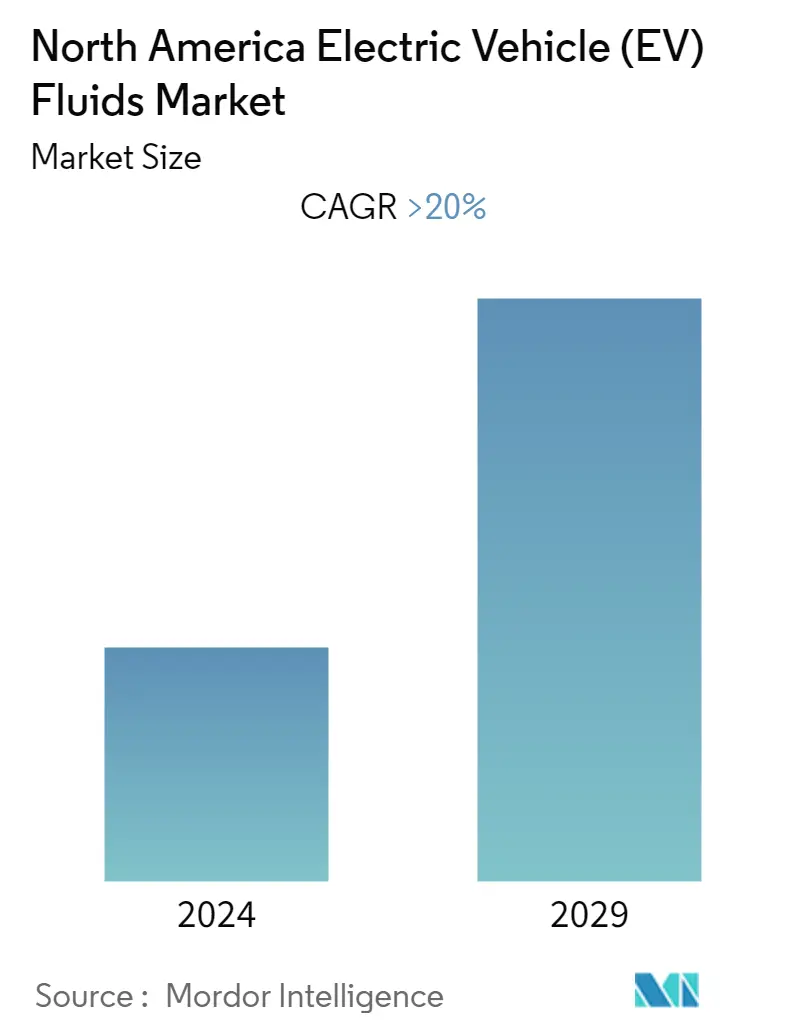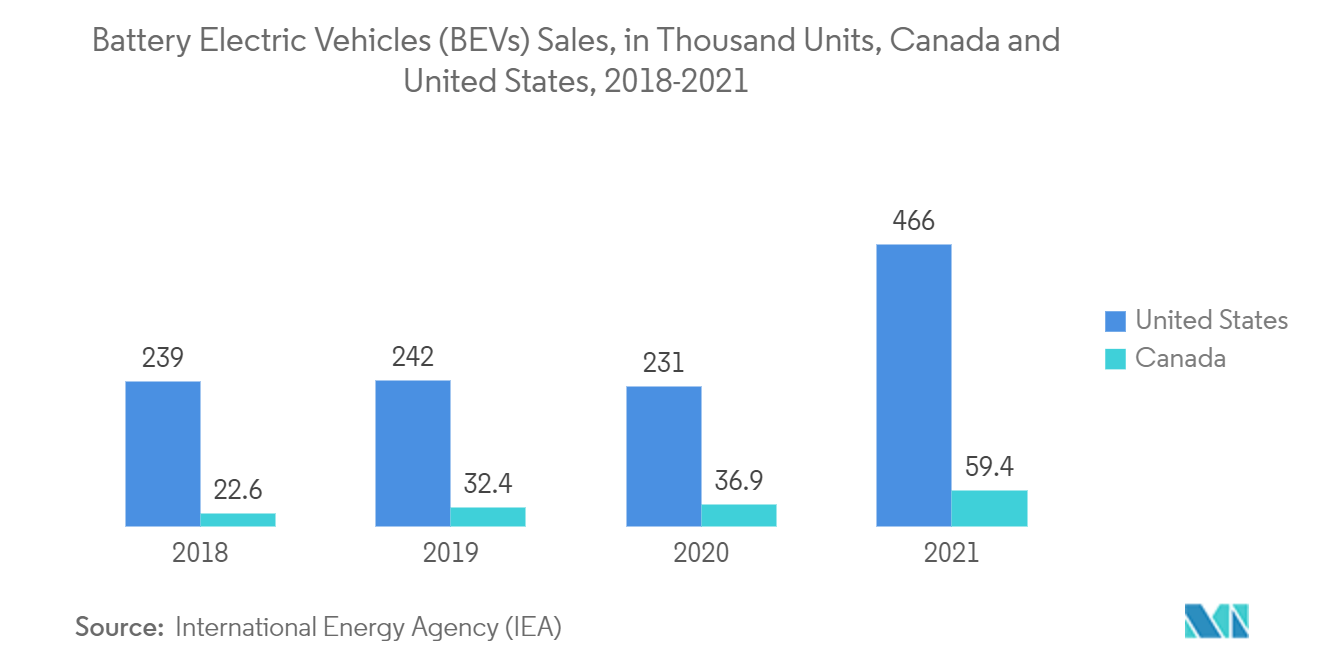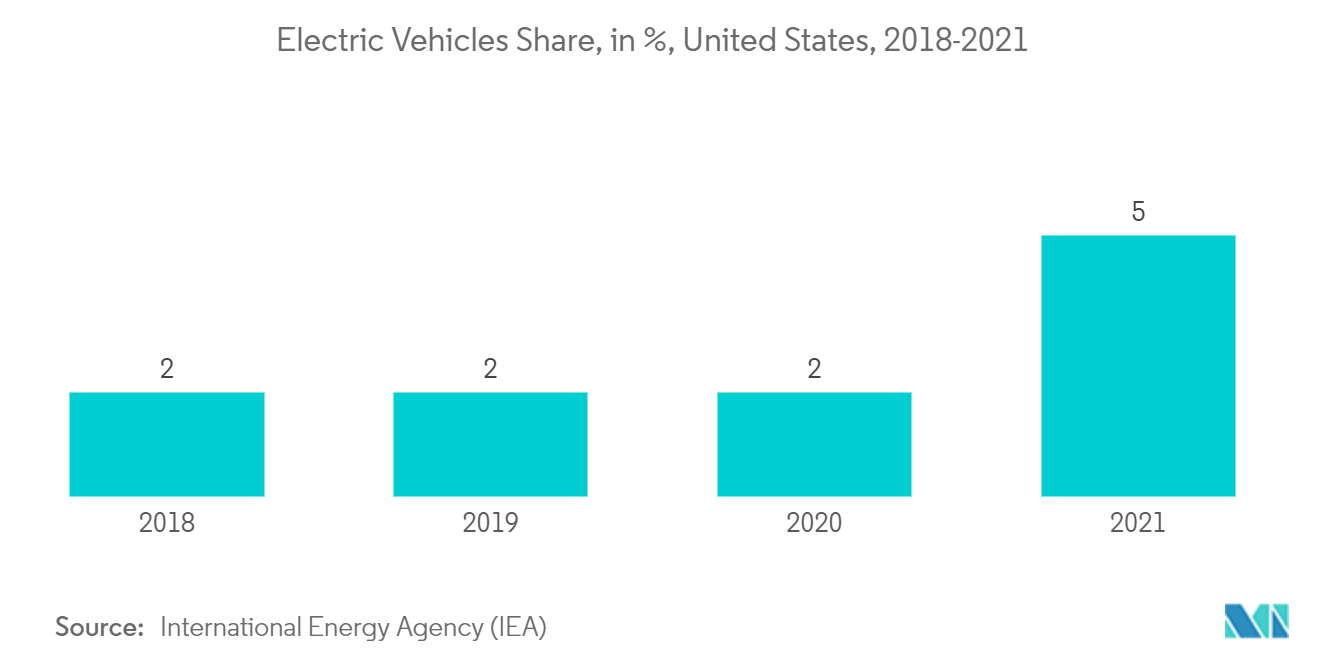North America Electric Vehicle (EV) Fluids Market Size

| Study Period | 2019 - 2029 |
| Base Year For Estimation | 2023 |
| Forecast Data Period | 2024 - 2029 |
| Historical Data Period | 2019 - 2022 |
| CAGR | 20.00 % |
| Market Concentration | Medium |
Major Players_Fluids_Market-_Key_Players.webp)
*Disclaimer: Major Players sorted in no particular order |
North America Electric Vehicle (EV) Fluids Market Analysis
The North American electric vehicle (EV) fluids market is estimated to register a CAGR of a over 20% during the forecast period.
The COVID-19 pandemic had a detrimental effect on the market as the demand for automobiles decreased substantially, thus decreasing the need for electric vehicles as well. However, the industry has picked up pace in the post-pandemic era and is expected to grow exponentially during the forecast period.
- Due to their low carbon emissions and excellent energy efficiency, electric vehicles are becoming increasingly popular, which is one of the key factors propelling the market ahead.
- The market being studied, however, is expected to be hampered by the initial high costs of electric vehicles compared to conventional petrol and diesel automobiles.
- Nevertheless, government policies to raise awareness and encourage the usage of electric vehicles will probably present opportunities for the industry under study.
- The United States accounted for the highest market share in the North American region and is expected to continue doing so in the forecast period.
North America Electric Vehicle (EV) Fluids Market Trends
Battery Electric Vehicles (BEVs) to Dominate the Market
- Battery electric vehicles are the type of electric vehicles that exclusively use chemical energy stored in rechargeable battery packs, with no secondary source of propulsion (a hydrogen fuel cell or internal combustion engine).
- These vehicles cannot run on conventional fluids since they might cause viscosity issues and corrosion of parts, reducing the vehicle's overall performance and durability. As a result, EV fluids enter the scene, which are created and adapted expressly to fulfill the needs of high-tech powertrains. These fluids are in charge of cooling the engine and transmission system, as well as maintaining the temperature of the battery and power electronics.
- Around 630,000 electric vehicles were sold in the United States in 2021, more than the combined sales of electric vehicles in the previous two years. About 75% of new EV sales were BEVs, which resulted in a higher share of BEVs relative to PHEVs in the market.
- Due to their great efficiency and low carbon emissions, BEV demand has been rising quickly in the North American region since the end of the epidemic era. According to the International Energy Agency's (IEA) Outlook 2022, the total number of BEVs registered in the United States in 2021 was estimated to be 466,000, or around two-thirds of the number of PHEVs registered.
- Moreover, the outlook also reported that the volume of battery electric car (BEV) sales in Canada increased to around 59,400 units in 2021. This figure represents an increase of about 61 percent compared with the previous year, when around 36,900 units were registered in the country for the first time.
- The region's expanding BEV industry has undoubtedly enticed BEV manufacturers to increase production to satisfy market needs. In North America, there are various battery-electric car models available, including model variants. While Tesla, Hyundai, and Audi are the only manufacturers offering more than one BEV in the United States, Nissan and Tesla provide numerous battery pack options for the LEAF and Model S, X, 3, and Y.
Furthermore, increasing efforts by major automotive OEMs to reduce greenhouse gas emissions and transform their product line-up into green, clean, and environmentally friendly vehicles are anticipated to propel the growth of the market during the forecast period.

United States to Dominate the Market
- The United States is a significant market for electric vehicles, and there is a positive movement taking place in the nation to adopt electric mobility. This is partially due to the abundance of technology and electric vehicle manufacturing startups and corporations operating in the nation, like Tesla, Rivian, Lucid, General Motors, etc. The market for EV fluids is anticipated to grow as a result of this trend toward electric vehicles.
- According to the EV volumes, EV sales in the United States increased by 48 percent year-on-year, despite a weak overall light vehicle market that plunged by 8 % for 2022 on a year-on-year basis. Moreover, for the United States and Canada combined, EV Volumes expects BEV & PHEV sales to grow by 71 %, for a share of 11.5 % in total light vehicle sales.
- The major driving factor for the growth of electric vehicles in the United States is the rising production of Tesla models and new-generation electric cars manufactured by other automakers. In the United States, Tesla accounts for more than 50% of all the units sold for electric vehicles.
- According to the IEA (International Energy Agency), in the United States, the federal aim is for electric vehicles (EVs) to make up 50% of new passenger cars and light trucks sold by 2030. Additionally, the country targets to make 10% of all vehicles electric by 2025 and reach 100% emission-free vehicles.
- Several major companies have also planned or initiated investing in the electric vehicle segment on account of the growing market. For instance, Link EV Electric Vehicles, a unit of the private United States energy company Citizens Resources, announced its plans to build an assembly plant in the central Mexican state of Puebla with an investment of around USD 265 million. The operations began in the second half of 2022 with four production lines with a nominal capacity of 1,200 units.
- All the aforementioned factors are expected to have a significant impact on the demand for the EV fluids market in the country over the forecast period.

North America Electric Vehicle (EV) Fluids Industry Overview
The North American electric vehicle (EV) fluids market is partially fragmented, with many players holding the majority share of the market. Some of the few players include (not in any particular order) Shell plc, Valvoline Global Operations, TotalEnergies, Exxon Mobil Corporation, and Petroliam Nasional Berhad (PETRONAS), among others.
North America Electric Vehicle (EV) Fluids Market Leaders
-
Shell plc
-
Valvoline Global Operations
-
TotalEnergies
-
Exxon Mobil Corporation
-
Petroliam Nasional Berhad (PETRONAS)
*Disclaimer: Major Players sorted in no particular order
_Fluids_Market-_Market_Concentration.webp)
North America Electric Vehicle (EV) Fluids Market News
- July 2022: Afton Chemical completed a USD 70 million investment in its Sauget, Illinois Plant's Automatic Transmission Fluid (ATF) additive production facility which will help support the growing needs of oil marketers and original equipment manufacturers (OEMs) for next-generation developments in electric vehicle (EV) fluids, including hybrid and battery electric vehicles (HEVs, BEVs).
- July 2022: Wakefield Canada Inc. announced the launch of Castrol ON, Castrol's new range of e-Fluids for electric mobility, including e-Greases, e-Thermal Fluids, and e-Transmission Fluids. The new Castrol ON range offers OEM partners and consumers a full range of advanced e-Fluids to meet the challenging technical demands of current and future electric vehicles.
Table of Contents
1. INTRODUCTION
- 1.1 Study Assumptions
- 1.2 Scope of the Study
2. RESEARCH METHODOLOGY
3. EXECUTIVE SUMMARY
4. MARKET DYNAMICS
-
4.1 Drivers
- 4.1.1 Increasing Popularity due to Low Carbon Emission and High Energy Efficiency
- 4.1.2 Other Drivers
-
4.2 Restraints
- 4.2.1 Initial High Costs of Electric Vehicles
- 4.3 Industry Value Chain Analysis
-
4.4 Porter's Five Forces Analysis
- 4.4.1 Bargaining Power of Suppliers
- 4.4.2 Bargaining Power of Buyers
- 4.4.3 Threat of New Entrants
- 4.4.4 Threat of Substitute Products and Services
- 4.4.5 Degree of Competition
5. MARKET SEGMENTATION (Market Size in Value)
-
5.1 Product Type
- 5.1.1 Engine Oil
- 5.1.2 Coolant
- 5.1.3 Transmission Fluids
- 5.1.4 Greases
- 5.1.5 Other Product Types
-
5.2 Propulsion Type
- 5.2.1 Battery Electric Vehicles (BEVs)
- 5.2.2 Hybrid Electric Vehicles (HEVs)
- 5.2.3 Plug-in Hybrid Electric Vehicles (PHEVs)
-
5.3 Vehicle Type
- 5.3.1 Passenger Vehicles
- 5.3.2 Commercial Vehicles
- 5.3.3 Other Vehicle Types
-
5.4 Geography
- 5.4.1 United States
- 5.4.2 Canada
- 5.4.3 Mexico
6. COMPETITIVE LANDSCAPE
- 6.1 Mergers & Acquisitions, Joint Ventures, Collaborations, and Agreements
- 6.2 Market Share (%) Analysis **/ Market Ranking Analysis
- 6.3 Strategies Adopted by Leading Players
-
6.4 Company Profiles
- 6.4.1 Afton Chemical
- 6.4.2 BP plc
- 6.4.3 Castrol Limited
- 6.4.4 ENEOS Corporation
- 6.4.5 Exxon Mobil Corporation
- 6.4.6 FUCHS
- 6.4.7 Gulf Oil International Ltd
- 6.4.8 Petroliam Nasional Berhad (PETRONAS)
- 6.4.9 Repsol
- 6.4.10 Shell plc
- 6.4.11 TETRA Technologies, Inc.
- 6.4.12 TotalEnegies
- 6.4.13 Valvoline Global Operations
- 6.4.14 Wakefield Canada, Inc.
- *List Not Exhaustive
7. MARKET OPPORTUNITIES AND FUTURE TRENDS
- 7.1 Government Policies to Raise Awareness Regarding Electric Vehicles
North America Electric Vehicle (EV) Fluids Industry Segmentation
Electric vehicle fluids are the range of fluids used in different vehicle components that are responsible for cooling the powertrain and transmission system while stabilizing the temperature of the battery and power electronics. Moreover, the EV fluids also carry out the function of heat transfer in the vehicles. The North American EV fluids market is segmented by product type, propulsion type, vehicle type, and geography. By product type, the market is segmented into the engine oil, coolant, transmission fluids, greases, and other product types. By propulsion type, the market is segmented into battery electric vehicles (BEVs), hybrid electric vehicles (HEVs), and plug-in hybrid electric vehicles (PHEVs). By vehicle type, the market is segmented into passenger vehicles, commercial vehicles, and other vehicle types. The report also covers the market size and forecasts for the EV fluids market in three countries across the North American region. For each segment, market sizing and forecasts have been done based on revenue (USD million).
| Product Type | Engine Oil |
| Coolant | |
| Transmission Fluids | |
| Greases | |
| Other Product Types | |
| Propulsion Type | Battery Electric Vehicles (BEVs) |
| Hybrid Electric Vehicles (HEVs) | |
| Plug-in Hybrid Electric Vehicles (PHEVs) | |
| Vehicle Type | Passenger Vehicles |
| Commercial Vehicles | |
| Other Vehicle Types | |
| Geography | United States |
| Canada | |
| Mexico |
Frequently Asked Questions
What is the current North America Electric Vehicle (EV) Fluids Market size?
The North America Electric Vehicle (EV) Fluids Market is projected to register a CAGR of greater than 20% during the forecast period (2024-2029)
Who are the key players in North America Electric Vehicle (EV) Fluids Market?
Shell plc, Valvoline Global Operations, TotalEnergies, Exxon Mobil Corporation and Petroliam Nasional Berhad (PETRONAS) are the major companies operating in the North America Electric Vehicle (EV) Fluids Market.
What years does this North America Electric Vehicle (EV) Fluids Market cover?
The report covers the North America Electric Vehicle (EV) Fluids Market historical market size for years: 2019, 2020, 2021, 2022 and 2023. The report also forecasts the North America Electric Vehicle (EV) Fluids Market size for years: 2024, 2025, 2026, 2027, 2028 and 2029.
North America Electric Vehicle (EV) Fluids Industry Report
Statistics for the 2024 North America Electric Vehicle (EV) Fluids market share, size and revenue growth rate, created by Mordor Intelligence™ Industry Reports. North America Electric Vehicle (EV) Fluids analysis includes a market forecast outlook to for 2024 to 2029 and historical overview. Get a sample of this industry analysis as a free report PDF download.



